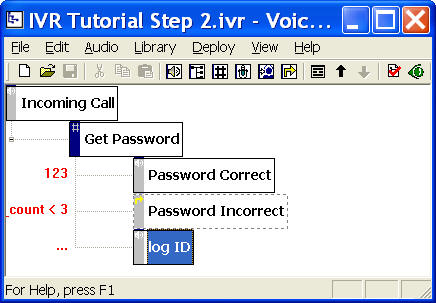2.5 Test
Lesson 2
The finished call flow diagram is shown below.

Validate and
Deployment
Validate the application
and submit it to Voicent
Gateway as show in Lesson 1. Use the same application
deployment name. When prompted, choose to overwrite the previous
deployed application.
Test Lesson 2 Once deployed, you can call in to test the application. The
following is a typical session:
- Caller: call in
- IVR: answer the call
- IVR: "Welcome to my broadcast
service. Please enter your password followed by the pound key"
- Caller: 1111#
- IVR: "Your password is incorrect"
- IVR: "Welcome to my broadcast
service. Please enter your password followed by the pound key"
- Caller: 2222#
- IVR: "Your password is incorrect"
- IVR: "Welcome to my broadcast
service. Please enter your password followed by the pound key"
- Caller: 3333#
- IVR: disconnect call
What's behind
the scene
The following explains how the IVR application controls the
interactions.
- Caller: call in
- IVR: answer the call
Incoming Call element
is active. Variable password_count is created and value
is set to 0. No action to take, transition to Get Password
element.
- IVR: Welcome to my broadcast
service. Please enter your password followed by the pound key
Get Password element is
active. First, all defined actions are executed. Here the set
variable value action is executed. The value of
password_count is incremented and becomes 1.
The system then plays all defined prompt items; since it is a
digits element, it waits for caller input.
- Caller: 1111#
- IVR: Your password is incorrect
Since the condition of the
first transition (equals 123) is not satisfied, the second
transition is used. The condition of the second transition is
password_count < 3, which is true when password_count
is 1.
The second transition changes the active element to Incorrect
Password. The prompt of that element is played. Since it is
a jump element, the system changes the active element to the target
element (Get Password).
- IVR: Welcome to my broadcast
service. Please enter your password followed by the pound key
Get Password element is
active. First, all defined actions are executed. Here the set
variable value action is executed. The value of
password_count is incremented and becomes 2.
The system then plays all defined prompt items; since it is a
digits element, it waits for caller input.
- Caller: 2222#
- IVR: Your password is incorrect
The condition of the first
transition is not satisfied, the second transition is used. The
condition of the second transition is password_count < 3,
which is true when password_count is 2.
The second transition changes the active element to Incorrect
Password. The prompt of that element is played. Since it is
a jump element, the system changes the active element to the target
element (Get Password).
- IVR: Welcome to my broadcast
service. Please enter your password followed by the pound key
Get Password element is
active. First, all defined actions are executed. Here the set
variable value action is executed. The value of
password_count is incremented and becomes 3.
The system then plays all defined prompt items; since it is a
digits element, it waits for caller input.
- Caller: 3333#
- IVR: disconnect call
The condition of the first
2 transitions are not satisfied, the third transition is used.
The condition of the second transition is password_count < 3,
which is false when password_count is 3.
The third transition changes the active element to Log ID.
The log message action is executed and prints out the caller ID
information in the log file. The IVR log file is usually under
C:\Program Files\Voicent\Gateway\apps\my_broadcast\logs.
No more transition is
defined. Disconnect the call.
The application
The application: Lesson_2_Variables.zip
 Video: Use Variables
Video: Use Variables
|